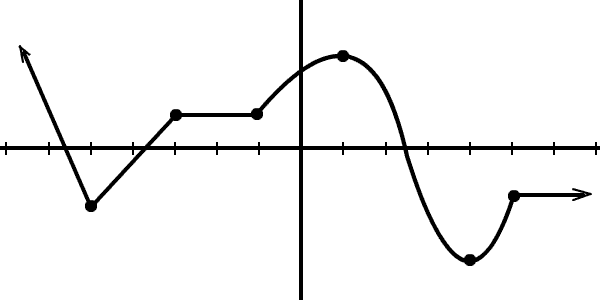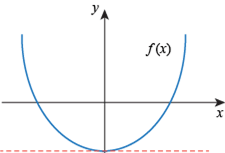Find the domain of y=x+3
All Real Numbers
 Is this graph represent a function?
Is this graph represent a function?
Yes
Which functions do not have a domain of all real numbers?
Square Root, Natural Log, Reciprocal
f(x)=x^3 and g(x)=√(x+5). Find f(x)+g(x)
x^3 + √(x+5)
Reflect the point (3,-4) across the y-axis
(-3,-4)
Find the domain of f(x)=x2
All real numbers
Where is this function decreasing?
(- infinity, -1] U [1, infinity)
Cosine, Absolute, Squaring
f(x)=x^3 and g(x)=√(x+5). Find f(x)/g(x)
x^3 /√(x+5)
Describe the transformation from the parent function y=x^3 to y=3(x+9)^3-6
vertical stretch by 3, horizontal translation 9 units to the left, and vertically translations 6 units down
Find the domain of 
[7,∞)
The reciprocal functions has what type of discontinuity?
Infinite
Which three functions have symmetry across the y-axis.
Cosine, Absolute, Squaring
Find the domain for the composition function
x^3 + √(x+5)
[-5,∞)
Reflect y=(x+6)^3 across the x-axis.
y=-(x+6)^3
Find the domain of 3x/(2x+6)
x ≠-3
Fill in the blank. This image is ________ at all x.

continuous
Which functions have points of discontinuity?
Reciprocal, greatest integer
What is g(x) if f(g(x))= (x-4)^5+2(x-4)^3
g(x)=x-4
Write the function for y=|x| being transformed by a horizontal shrink of 1/2, reflected across the y-axis, and vertically translated up 11 units.
y=|-2x|+11
Find the domain of (6x+1)/√(3-x)
x < 3
Is this graph bounded above, below, or both?

Below
Which functions have an asymptote at y=0
Logistic, Exponential, Reciprocal
f(x)=x^5+x^3+3x and g(x)=x+3. Find f(g(1))
1100
Apply a horizontal stretch of 1/6 to the functions y=3x^2
y=18x^2